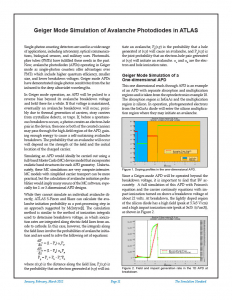Geiger Mode Simulation of Avalanche Photodiodes in ATLAS
Single-photon counting detectors are used in a wide range of applications, including astronomy, optical communications, biological sensors, and military uses. Photomultiplier tubes (PMTs) have fulfilled these needs in the past. Now, avalanche photodiodes (APDs) operating in Geiger mode as single-photon counters offer advantages over PMTs which include higher quantum efficiency, smaller size, and lower breakdown voltages. Geiger mode APDs have demonstrated single-photon sensitivites from the far infrared to the deep ultraviolet wavelengths.
In Geiger mode operation, an APD will be pulsed to a reverse bias beyond its avalanche breakdown voltage and held there for a while. If that voltage is maintained, eventually an avalanche breakdown will occur, possibly due to thermal generation of carriers, stray carriers from crystalline defects, or traps. If, before a spontaneous breakdown occurs, a photon creates an electron-hole pair in the device, then one or both of the created carriers may pass through the high-field region of the APD, gaining enough energy to cause a self-sustaining avalanche breakdown. The probability that an avalanche will occur will depend on the strength of the field and the initial location of the charged carrier.
Simulating an APD would ideally be carried out using a full-band Monte Carlo (MC) device model that incorporates realistic band structures for each APD geometry. Unfortunately, these MC simulations are very compute-intensive. MC models with simplified carrier transport can be more practical, but the calculation of avalanche initiation probablities would imply many reruns of the MC software, expecially for 2- or 3-dimensional APD designs.
While they cannot simulate an individual avalanche directly, ATLAS S-Pisces and Blaze can calculate the avalanche initiation probability as a post-processing step in an approach suggested by McIntyre[1]. The calculation method is similar to the method of ionization integrals used to determine breakdown voltage, in which ionization rates are integrated along electric field lines from anode to cathode. In this case, however, the integrals along the field lines involve the probabilities of avalanche initiation and are used to solve the following set of equations:



